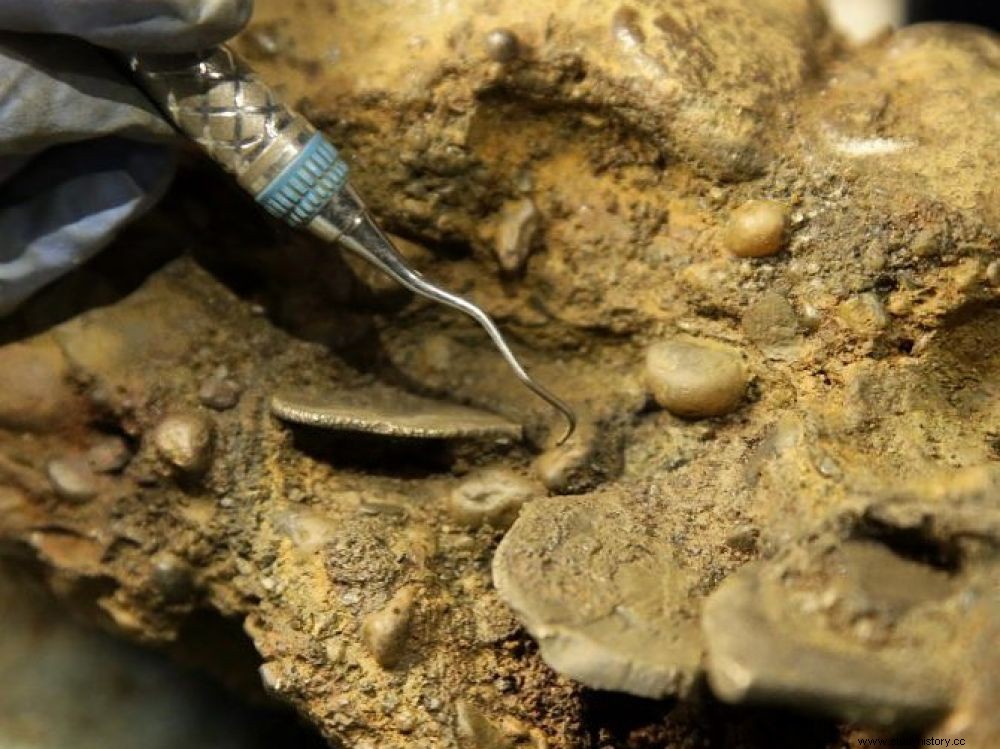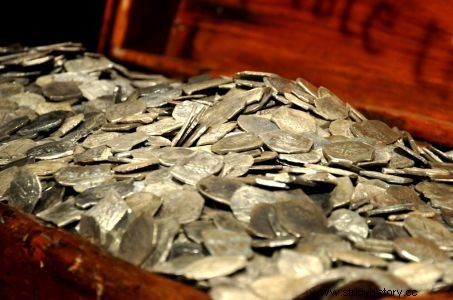Nearly 35 years after the discovery of the one and only authenticated pirate shipwreck - that of the Whydah Gally , which sank in a storm in 1717 -, six new skeletons have just been discovered by underwater explorers, preserved in concretions. The researchers hope to be able to identify that of "Black Sam" Bellamy, a legendary English pirate who may have been the richest of all.

Concretions containing silver coins found in 2016 in the wreck of the Whydah. The bones could have been preserved in this way.
Many over-30s dreamed as a child of having an adventure worthy of the Goonies , film by Richard Donner released in 1985:to save his family home in Oregon about to fall into the hands of real estate developers, Mickey Walsh, 13, sets out with his band in search of the pirate ship of Willy le Borgne . The wreck, never located, would contain on board an invaluable treasure. The legend says that the pirate, refusing to admit defeat against the fleet of the English crown, took refuge with his ship and his men in a cave that eventually became his tomb. Under the fire of the cannons, the stones blocked the exit forever... This story is obviously only the scenario of this feature film which marked a whole generation of teenagers. But it is reminiscent of the very real one of the legendary Samuel Bellamy, an English pirate who disappeared with his treasure in the sinking of his ship on April 26, 1717, off Cape Cod, in the northeastern United States. United.
A wreck, a treasure, but no captain
It has actually been a long time since Bellamy's ship, the Whydah Gally , was located. In 1984, with his team, underwater archaeologist Barry Clifford discovered the wreck of this 300-ton English ship with 18 guns 6 km from the coast, which Bellamy had proudly seized in February 1717, while he was laden with sugar, indigo, gold, silver, ivory and especially slaves, just torn from Africa to reach the Caribbean. With this find, Barry Clifford listed the world's only proven pirate shipwreck as a heritage site. At the time, the newspapers spoke of a booty of 400 million dollars! But if we judge by the value of the 8,000 artifacts brought up from the depths, including gold coins, we are still far from the mark. Dueling pistols, the ship's bell, cannons, inks, terracotta sailors' pipes or even pieces of clothing were released from a thick layer of sand located 7 meters deep, making the exploration of difficult wreckage. All of these items can be seen today at the Whydah Pirate Museum on Cape Cod. But one last treasure, arguably the most valuable, has never been found:Bellamy's body himself, which archaeologists believe may not yet have disappeared, eaten away by scum.

Part of the gold recovered from the wreck of the Whydah in 1984 by Barry Clifford. Credits:Wikimedia Commons
Six skeletons found
What if the explorers just got their hands on it? A few days ago, the Whydah Pirate Museum announced in a press release that it had found several concretions containing six skeletons near the wreck of the Whydah. Concretions are solid mineral masses that form around a tissue or an organ and thus allow the preservation of organic matter or other objects for several centuries in salt water. If the bones have not yet been analyzed, they are already exciting archaeologists, who hope to identify the remains of Sam Bellamy there.
Many over-30s dreamed as a child of having an adventure worthy of the Goonies , film by Richard Donner released in 1985:to save his family home in Oregon about to fall into the hands of real estate developers, Mickey Walsh, 13, sets out with his band in search of the pirate ship of Willy le Borgne . The wreck, never located, would contain on board an invaluable treasure. The legend says that the pirate, refusing to admit defeat against the fleet of the English crown, took refuge with his ship and his men in a cave that eventually became his tomb. Under the fire of the cannons, the stones blocked the exit forever... This story is obviously only the scenario of this feature film which marked a whole generation of teenagers. But it is reminiscent of the very real one of the legendary Samuel Bellamy, an English pirate who disappeared with his treasure in the sinking of his ship on April 26, 1717, off Cape Cod, in the northeastern United States. United.
A wreck, a treasure, but no captain
It has actually been a long time since Bellamy's ship, the Whydah Gally , was located. In 1984, with his team, the underwater treasure hunter Barry Clifford discovered 6 km from the coast the wreck of this English ship of 300 tons and 18 guns, which had proudly seized Bellamy in February 1717, then that it was laden with sugar, indigo, gold, silver, ivory and especially slaves, just torn from Africa to reach the Caribbean. With this find, Barry Clifford listed the world's only proven pirate shipwreck as a heritage site. At the time, the newspapers spoke of a booty of 400 million dollars! But if we judge by the value of the 8,000 artifacts brought up from the depths, including gold coins, we are still far from the mark. Dueling pistols, the ship's bell, cannons, inks, terracotta sailors' pipes or even pieces of clothing were released from a thick layer of sand located 7 meters deep, making the exploration of difficult wreckage. All of these items can be seen today at the Whydah Pirate Museum on Cape Cod. But one last treasure, arguably the most valuable, has never been found:Bellamy's body himself, which archaeologists believe may not yet have disappeared, eaten away by scum.

Part of the gold recovered from the wreck of the Whydah in 1984 by Barry Clifford. Credits:Wikimedia Commons
Six skeletons found
What if the explorers just got their hands on it? A few days ago, the Whydah Pirate Museum announced in a press release that it had found several concretions containing six skeletons near the wreck of the Whydah. Concretions are solid mineral masses that form from submerged metal around a tissue, organ, or simple object. The phenomenon thus allows the preservation of any material, and for example organic, for several centuries in salt water. If the bones have not yet been analyzed, they are already exciting the experts, who hope to identify the remains of Sam Bellamy there.
In 2018, the latter believed for a time to have identified some of Bellamy's bones after finding a skeleton alongside a pistol and a pocket of gold. But the DNA tests came back negative. Indeed, in the same year, a member of the Whydah Museum was able to obtain the hacker's DNA through a descendant in England. The remains found ultimately belonged to a member of the pirate crew under Bellamy, "a male individual with general ties to the eastern Mediterranean region" , reports the press release. "But these newly discovered bones may finally lead us to Bellamy." Researchers also hope " that modern, cutting-edge technology will help identify these pirates and reunite them with any descendants who may still be alive" , Barry Clifford told local media, including local TV channel WHDH .
Piracy, wine and democracy
Sam Bellamy, also called "Black Sam" because he preferred his natural black hair to the powdered wigs of the time, was an English citizen who became a pirate in the year 1716. In just one year of piracy, he forged a fearsome reputation :he captured 53 ships, to the point of becoming at that time the richest pirate of all time. But fate wanted his fall as dazzling as his rise. On April 26, 1717, as he was going to join his mistress ashore, he perished alongside his 143 men on the Whydah , in a storm, off capricious Cape Cod. We know that alcohol was not for nothing in the drama that evening. Bellamy had captured the Mary Ann a few days earlier. , a three-master heavy with a full load of Madeira wine. According to the few testimonies given by the survivors (and captives) of the Mary Ann , the pirates had gotten so drunk that they could no longer control the two ships… Only two men out of the 146 on board survived and managed to swim to shore, a certain John Julian and the ship’s carpenter, Thomas David. Both were acquitted as "involuntary" participants.
The Whydah remained several days keel in the air, 6 kilometers from the coast. Enough to attract coastal looters, in a hurry to help themselves to the rich cargo of the boat. The men of the governor of Massachusetts, who arrived on the spot more than a week after the sinking, only saved some 200 pounds of goods and some marine objects. This is why the explorers, two centuries later, probably did not find the gold and precious materials supposed to be on board.
The New England Historical Society explains that Bellamy considered himself the "Robin Hood of the Sea" and called his crew "Robin Hood's Men". Because against all odds, he democratically led his crew. "His men were slaves, Indians and sailors in his service. Bellamy treated them as equals and let them vote in important decisions." Concerned about the well-being of his crew, and even his prisoners, his art of motivating his troops also contributed to his aura. Far from the image of the rude and bloodthirsty pirate, closer to that of a gentleman in thirst for social justice (and pomp), he will also be nicknamed the "Prince of Pirates". It remains to be seen whether the bones found are indeed princely.
